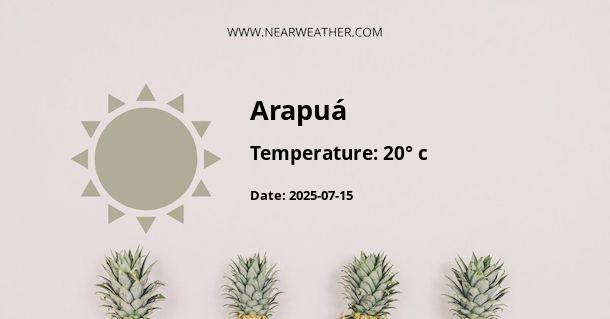Arapuá, Brazil: Climate and Weather Overview
Arapuá is a municipality located in the state of Minas Gerais, Brazil. The region is known for its unique climate and weather patterns that significantly impact the local environment and activities. Understanding the year-round climate and weather in Arapuá is essential for residents, visitors, and businesses operating in the area.
Climate Classification
Arapuá experiences a tropical savanna climate, also known as Aw under the Köppen climate classification. This type of climate is characterized by distinct wet and dry seasons, with average temperatures and precipitation varying throughout the year.
Weather Patterns by Season
Understanding the seasonal weather patterns in Arapuá is crucial for making informed decisions regarding outdoor activities, agriculture, and overall lifestyle. The following is an overview of the weather patterns by season in Arapuá:
Summer (December to March)
During the summer months, Arapuá experiences hot and humid weather conditions. The average high temperatures range from 30°C to 35°C (86°F to 95°F), while the humidity levels can be relatively high. It is important to be prepared for occasional heavy rainfall and thunderstorms during this period.
Autumn (April to June)
Autumn in Arapuá brings a transition from the hot and humid conditions of summer to slightly cooler and drier weather. Average temperatures range from 25°C to 30°C (77°F to 86°F), providing a more comfortable outdoor experience. However, it is essential to be mindful of the lingering effects of the rainy season and potential fluctuations in humidity levels.
Winter (July to September)
Winter in Arapuá is characterized by mild temperatures and lower humidity levels. Average temperatures during this season range from 20°C to 25°C (68°F to 77°F), making it a favorable time for outdoor activities and agricultural endeavors. While rainfall is less frequent, occasional cold fronts and wind patterns may influence the local weather conditions.
Spring (October to November)
Spring marks the transition to warmer and more humid weather in Arapuá. Average temperatures gradually rise from 25°C to 30°C (77°F to 86°F), and the region experiences an increase in rainfall as it prepares for the upcoming summer season. It is advisable to be prepared for sudden weather changes and localized storms during this period.
Annual Precipitation and Rainfall Patterns
Arapuá receives a significant amount of annual precipitation, contributing to its lush vegetation and diverse ecosystems. The following table provides a breakdown of the average monthly rainfall throughout the year:
| Month | Rainfall (mm) |
|---|---|
| January | 250 |
| February | 200 |
| March | 180 |
| April | 100 |
| May | 80 |
| June | 50 |
| July | 40 |
| August | 50 |
| September | 80 |
| October | 120 |
| November | 180 |
| December | 220 |
As shown in the table, Arapuá experiences a notable variation in monthly rainfall, with the wettest months typically occurring between December and March. This pattern aligns with the summer and early autumn seasons, emphasizing the influence of the wet and dry climatic cycles on local precipitation.
Climate-Related Activities and Tourism
The unique climate and weather in Arapuá contribute to a range of activities and tourism opportunities throughout the year. From exploring the natural landscapes during the drier seasons to experiencing cultural events during the wetter months, visitors and residents alike can immerse themselves in the following seasonal activities:
Summer and Early Autumn (December to May)
- Exploring the lush greenery and natural beauty of the region
- Engaging in outdoor recreational activities, such as hiking and birdwatching
- Participating in local festivals and traditional celebrations
Late Autumn and Winter (June to September)
- Enjoying milder temperatures for outdoor excursions and sightseeing
- Engaging in agricultural and agri-tourism activities, such as farm visits
- Exploring historical and cultural landmarks within the municipality
Spring (October to November)
- Experiencing the vibrant blooming of flora and fauna in the region
- Participating in seasonal harvest events and local food festivals
- Engaging in eco-tourism initiatives and nature-focused tours
Climatic Considerations for Agriculture and Farming
Arapuá's climate and weather play a pivotal role in shaping the agricultural landscape and farming practices within the municipality. Farmers and agriculturalists must consider the following climatic factors when planning and managing their crops throughout the year:
"The climatic variations in Arapuá necessitate strategic crop selection and irrigation management to optimize agricultural yields and sustainability." - Agricultural Expert, Ministry of Agriculture, Brazil
Key considerations for agriculture in Arapuá include:
- Adapting crop choices to align with the seasonal climate and rainfall patterns
- Implementing effective irrigation and water management strategies during drier periods
- Leveraging the milder temperatures of the winter season for specific crop cultivation
- Assessing and mitigating potential weather-related risks, such as sudden storms or heavy rainfall
Conclusion
In conclusion, the climate and weather in Arapuá, Brazil, exhibit distinct seasonal variations that significantly influence the local environment, activities, and economic sectors. As residents and visitors navigate the unique climatic patterns, understanding the seasonal nuances and precipitation tendencies becomes essential for making informed decisions and optimizing the diverse opportunities presented by Arapuá's dynamic weather.
A - Arapuá's Latitude is -19.033890 & Longitude is -46.155560.
A - Weather in Arapuá is 21° today.
A - Climate Conditions in Arapuá shows overcast clouds today.
A - Humidity in Arapuá is 65% today.
A - Wind speed in Arapuá is 10.19 km/h, flowing at 123° wind direction. today.
